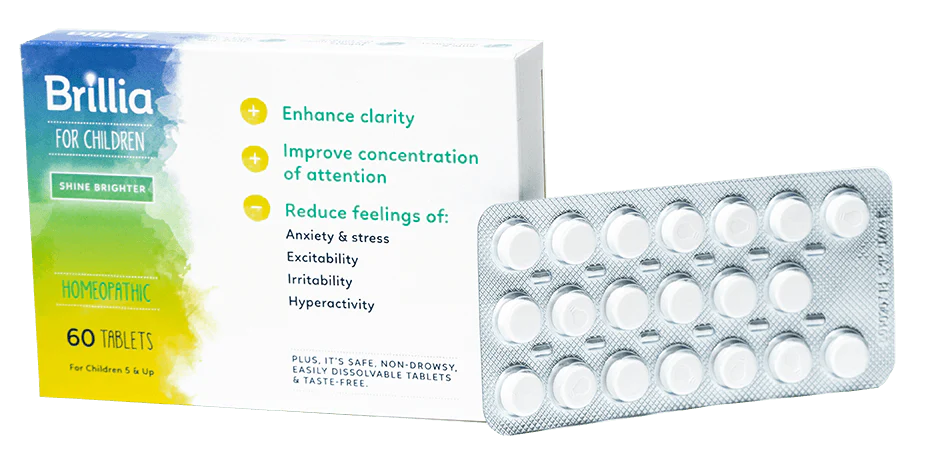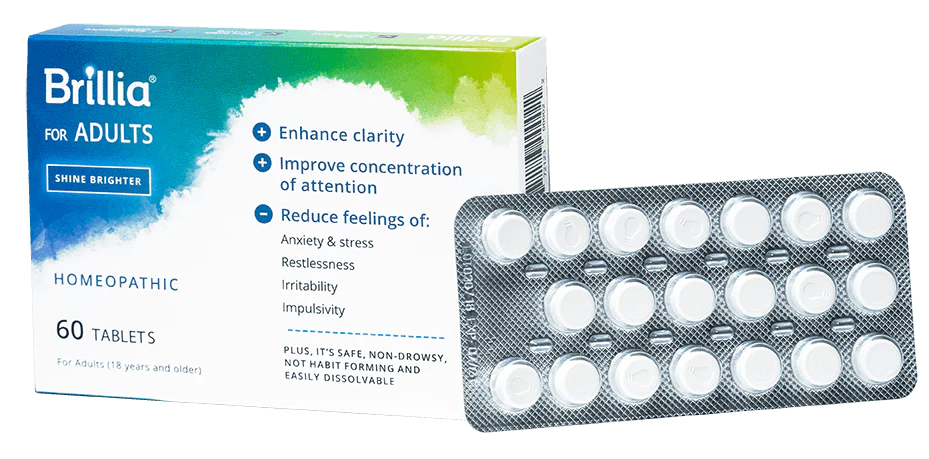Brillia vs Adderall
An estimated 2.5 million children have been prescribed stimulants like Adderall to treat symptoms of ADHD and ADD.1 Adderall is also commonly misused by young adults who acquire the drug from family or friends to study harder, lose weight, and even perform better athletically. Though widely used in the U.S. by children and adults alike, there are a number of side effects and risks that should be considered before adding Adderall to your daily routine. Find out how the drug works, what to expect when taking it, and how Adderall compares to homeopathic medications like Brillia.
What is Adderall?
Adderall is a synthetic drug composed of amphetamine and dextroamphetamine, which are central nervous system stimulants that impact chemicals in the brain and nerves that contribute to hyperactivity and impulsivity. The drug is commonly prescribed to treat ADHD, ADD, and narcolepsy. It can help increase one’s ability to pay attention, stay focused on an activity, and control behavior problems. It may also help improve listening skills. According to the Cleveland Clinic, stimulants like Adderall reduce symptoms of ADHD in 70 to 80 percent of children, and in 70 percent of adults, especially when combined with behavioral therapy.2
How Adderall Works
Stimulants like Adderall regulate impulsive behavior and improve focus by increasing the levels of certain chemicals in the brain, such as dopamine, the reward chemical in the brain. Adderall also increases epinephrine and norepinephrine, which enhance the fight-or-flight response to trigger alertness, clarity, and focus. These chemical reactions may contribute to a cascade of side effects, including decreased appetite, constricted blood vessels, and a spike in blood pressure.
Common side effects of taking Adderall include:
- Headache
- Upset stomach
- Decreased appetite
- Dry mouth
- Dizziness
- Nervousness
- Insomnia
Less common, but possible reactions include:
- Itchy skin, a rash, or hives
- Growth reduction in children
- Visual disturbances or blurred vision
- Hallucinations
- Swelling of the tongue or face
- Withdrawal symptoms
Shine Brighter
Brillia vs Adderall for ADHD & ADD
Unlike Adderall, Brillia is a non-prescription medication that uses antibodies as its active ingredient in lieu of harsh synthetic chemicals.
While Adderall is associated with a range of physiological side effects, Brillia’s targeted approach ensures that ADHD and ADD symptoms are addressed gently and impactfully without affecting any other systems in the body. Adderall is highly habit-forming, with emergency room visits rising 156 percent over a six-year period due to the drug, but Brillia can be started or stopped at any time.3 There are no “coming off” symptoms associated with the medication and Brillia causes no harmful side effects. As a result of the regulating effect of Brillia on the protein S-100, the level of monoamines (dopamine, norepinephrine, serotonin) in different parts of the brain normalizes. This is a safer and more efficient way of helping dopamine, norepinephrine and serotonin levels without the use of synthetic chemicals in prescription medications like Adderall.
Speaking of safety, some users take Brillia alongside other prescribed medications or supplements as there are no contraindications or dangerous interactions. Adderall, on the other hand, should never be combined with MAO inhibitors and the drug is discouraged by those who have glaucoma, an overactive thyroid, severe anxiety, high blood pressure, heart disease, vascular disease or hardening of the arteries, or a history of drug or alcohol addiction.4 Brillia is safe to use by children as well as adults.
Brillia Ingredients vs Adderall
While Adderall relies on amphetamine and dextroamphetamine to stimulate the central nervous system, Brillia relies on antibody science. Brillia’s active ingredient consists of antibodies to the brain-specific S100B protein, which plays an important role in mood regulation, focus, and neuroplasticity. Research shows that ADHD symptoms like inattention and hyperactivity are associated with an imbalance of the S100B protein.5 Brillia targets ADHD and ADD symptoms at the source by attaching to the S100B protein and changing its shape so it cannot instigate symptoms altogether. Because of the gentle approach of Brillia, the medication is available without an official diagnosis or prescription, unlike Adderall, which requires both.
While Adderall is most effective when combined with behavioral therapy, Brillia works best in tandem with healthier lifestyle choices outlined in the 5-Pillar methodology. Since attention issues are exacerbated by dietary choices, poor sleep hygiene, excessive screen use, and stress, the 5 Pillars provide customers with resources to help them eat healthy foods, get more sleep, practice relaxation and mindfulness techniques, and control their screen time to focus better and feel more balanced in their daily lives.
Though Adderall may be the best option for some, we do recommend that they try Brillia first before resorting to prescription medications. Some users even choose to take Brillia in conjunction with their prescription medications in lieu of increasing dosage. Learn more about how Brillia works, find out what happy customers have said about their Brillia journey, and find more resources and tools at the Brillia blog.
We’ll share helpful tips, the latest studies and personal experiences.







